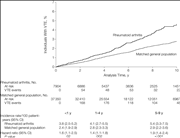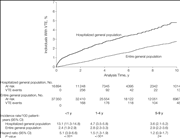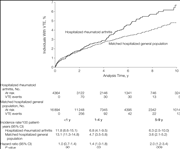文献:Holmqvist ME et al.Risk of Venous Thromboembolism in Patients With Rheumatoid Arthritis and Association With Disease Duration and Hospitalization.JAMA. 2012;308(13):1350-1356.
関節リウマチ(RA)患者4万5760人を対象に、静脈性血栓塞栓症(VTE)のリスクを前向き集団コホート研究で検証。RA有病者は一般集団よりVTEリスクが高かった(調整ハザード比2.0)。リスクはRAと診断後の1年で上昇、10年間は高いままだった。入院はVTEのリスク因子だったが、一般集団とRA患者でリスクは同等だった。
Risk of Venous Thromboembolism in Patients With Rheumatoid Arthritis and Association With Disease Duration and Hospitalization
Marie E. Holmqvist, MD, PhD; Martin Neovius, PhD; Jonas Eriksson, MSc; Angla Mantel; Solveig Wallberg-Jonsson, MD, PhD; Lennart T. H. Jacobsson, MD, PhD; Johan Askling, MD, PhD
JAMA. 2012;308(13):1350-1356. doi:10.1001/2012.jama.11741.
ABSTRACT
Context Recent reports suggest that rheumatoid arthritis (RA) may be a risk factor for venous thromboembolism (VTE), particularly in conjunction with hospitalization. Using hospitalization data to identify RA and VTE may identify patients when they are at elevated risk for other reasons, obscuring the incompletely understood underlying association between RA and VTE and leading to inappropriate institution or timing of interventions.
Objective To estimate risks for VTE in patients with RA, including the relation of these risks to disease duration and hospitalization.
Design, Setting, and Patients Prospective, population-based cohort study of 1 prevalent RA cohort (n = 37 856), 1 incident RA cohort (n = 7904), and matched general population comparison cohorts, all from Sweden, with follow-up from 1997 through 2010.
Main Outcome Measure First-time VTE.
Results Patients with prevalent RA were at greater risk of VTE than the general population (rate, 5.9 [95% CI, 5.1-6.6] vs 2.8 [95% CI, 2.6-3.1] per 1000 person-years (adjusted hazard ratio [HR], 2.0 [95% CI, 1.9-2.2]; P < .001). By the time of RA symptom onset, there was no statistically significant association between a history of VTE and RA (odds ratio, 1.2 [95% CI, 1.0-1.4]; P = .08; 150 events in the RA cohort vs 587 in the comparison cohort). Counting from RA diagnosis, an increased rate in the RA cohort vs the comparison cohort (3.8 [95% CI, 2.5-5.2] vs 2.4 [95% CI, 1.9-2.9] per 1000 person-years; HR, 1.6 [95% CI, 1.1-2.5]; P = .02) was detected within the first year and did not increase further during the first decade. Although rates for VTE following hospitalization were higher, the 1-year rate of VTE per 1000 person-years was not higher in the RA cohort than in the comparison cohort after hospital discharge (11.8 [95% CI, 8.6-15.1] vs 13.1 [11.3-14.8]; HR, 1.0 [95% CI, 0.7-1.4]; P = .90). The rates of VTE increased with age but were largely similar across sex and rheumatoid factor status, as were the HRs for VTE across age, sex, and rheumatoid factor status.
Conclusions Compared with the general population, Swedish patients with RA had an elevated risk for VTE that was stable over the first 10 years after diagnosis. Although hospitalization was a risk factor for VTE the first year after discharge, the excess risk was not greater in patients with RA than in the general population.



![]()
![]()
![]()
![]()